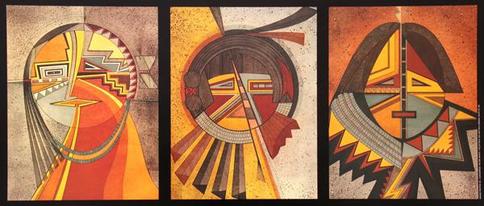
Helen Hardin, The Woman Series:
Changing Woman, Medicine Woman, and Listening Woman, 1981-1984,
Helen Hardin (May 28, 1943 – June 9, 1984) (also known as Tsa-sah-wee-eh, which means "Little Standing Spruce") was an American painter. Her parents were Santa Clara Pueblo artist, Pablita Velarde and a Caucasian former police officer and Chief of Public Safety, Herbert Hardin. She started making and selling paintings, participated in University of Arizona's Southwest Indian Art Project and was featured in Seventeen magazine, all before she was 18 years of age. Creating art was a means of spiritual expression that developed from her Roman Catholic upbringing and Native American heritage. She created contemporary works of art with geometric patterns based upon Native American symbols and motifs, like corn, kachinas, and chiefs. In 1976 she was featured in the PBS American Indian artists series.
She was a studio artist, who from the 1960s to mid 1970s lectured and exhibited paintings at Albuquerque's Enchanted Mesa Gallery. Hardin's early artistic works were characterized as traditionally realistic and she signed them with her Tewa name, Tsa-Sah-Wee-Eh. She was influenced by her spirituality and the protective, supportive "angels" in her life.
Up to 26 layers of paint - including ink washes, acrylics, airbrush and varnish - were applied to create her works; Hardin painted tiny dots called stipples; spattered paint with a toothbrush, like Anasazi pottery; and applied transparent washes.
In 1964 Hardin made the painting Medicine Talk for her first major solo exhibition at Enchanted Mesa. While with her father in 1968 in Bogotá, Colombia, she began painting in earnest and had a successful show at the American Embassy, where she sold 27 paintings. Since her reputation in the United States was tied with her mother's success, she had not been sure the degree to which she had success based upon her own merit. In Columbia her success was based on her talent alone.
When she returned to United States, her art became more geometric and abstract, and she used deep colored paints. Hardin was said to have brought a "new look" to Native American art by New Mexico Magazine. The publicity was a turning point in her career, its publicity led to greater success and recognition. In 1971 she had a show in Guatemala City.
As her career matured and she gained confidence, Hardin became known for painting complex works that combined colorful images and symbols from her Native American heritage with modern abstract art techniques. Her work frequently incorporated images of women, chiefs, kachinas and designs from pueblo pottery, and integrated modern elements as her career advanced. For instance, the paintings of kachinas and blanketed chiefs integrated geometric patterns made with drafting templates, rulers and protractors. Kachinas, or heavenly messengers, had special spiritual meaning, similar to the saints from her Catholic tradition, connecting between people on earth and heaven.
She was filmed in 1976 for a series on American Indian artists for Public Broadcasting System (PBS). Other filmed artists included R. C. Gorman, Charles Loloma, Allan Houser, Joseph Lonewolf, and Fritz Scholder.
Bountiful Mother made in 1980 represents two aspects of motherhood from the Pueblo and Hopi culture: Corn Mother and Mother Earth. The cultivation and consumption of corn was so central to the pueblo culture that it was "... a living entity with a body similar to man's in many respects ...the people built its flesh into their own." In the work, the woman's fertility is symbolized by the kernels of blue corn of her body. In 1981 she made the self-portrait Metamorphosis: "The features were contained within a perfect circle, a Jungian archetype of psychic wholeness and the symbol for Hardin of life itself, but everything else about the painting was fragmented, jagged and asymmetrical," said Jay Scott, her biographer, of the "tormented pieces of her life."
At her death at the age of 41, Hardin was recognized as one of the finest and most innovative Indian artists of her generation. She was among the first modern Indian painters to combine her non-Indian art materials and techniques with an Indian sensibility, merging past and present in a new way.
She created a series that included Changing Woman, Medicine Woman, and Listening Woman. The last work, Creative Woman was intended to be part of the series but the she died before it was created. The paintings portrayed the "intellectual, emotional, and sensitive" aspects of womanhood.
Hardin was commissioned to create children's book illustrations for Clarke Industries and design coins for Franklin Mint's History of the American Indian series.
She received honors for her work at the Heard Museum, Scottsdale National Indian Arts Exhibition, Philbrook Art Center, the Inter-Tribal Ceremonial at Gallup, New Mexico, and the Santa Fe Indian Market. At these shows she won "Best of Show", first prize and grand awards.*
*https://en.wikipedia.org/wiki/Helen_Hardin
*https://en.wikipedia.org/wiki/Helen_Hardin
BEN
Kin 153: Red Planetary Skywalker
I perfect in order to explore
Producing wakefulness
I seal the output of space
With the planetary tone of manifestation
I am guided by the power of birth
I am a galactic activation portal
Enter me.
The six mental spheres of consciousness are ethereally congruent with the brain, and serve as the computer or hardware of the mind.*
*Star Traveler's 13 Moon Almanac of Synchronicity, Galactic Research Institute, Law of Time Press, Ashland, Oregon, 2015-2016.
The Sacred Tzolk'in
Manipura Chakra (Limi Plasma)




No comments:
Post a Comment